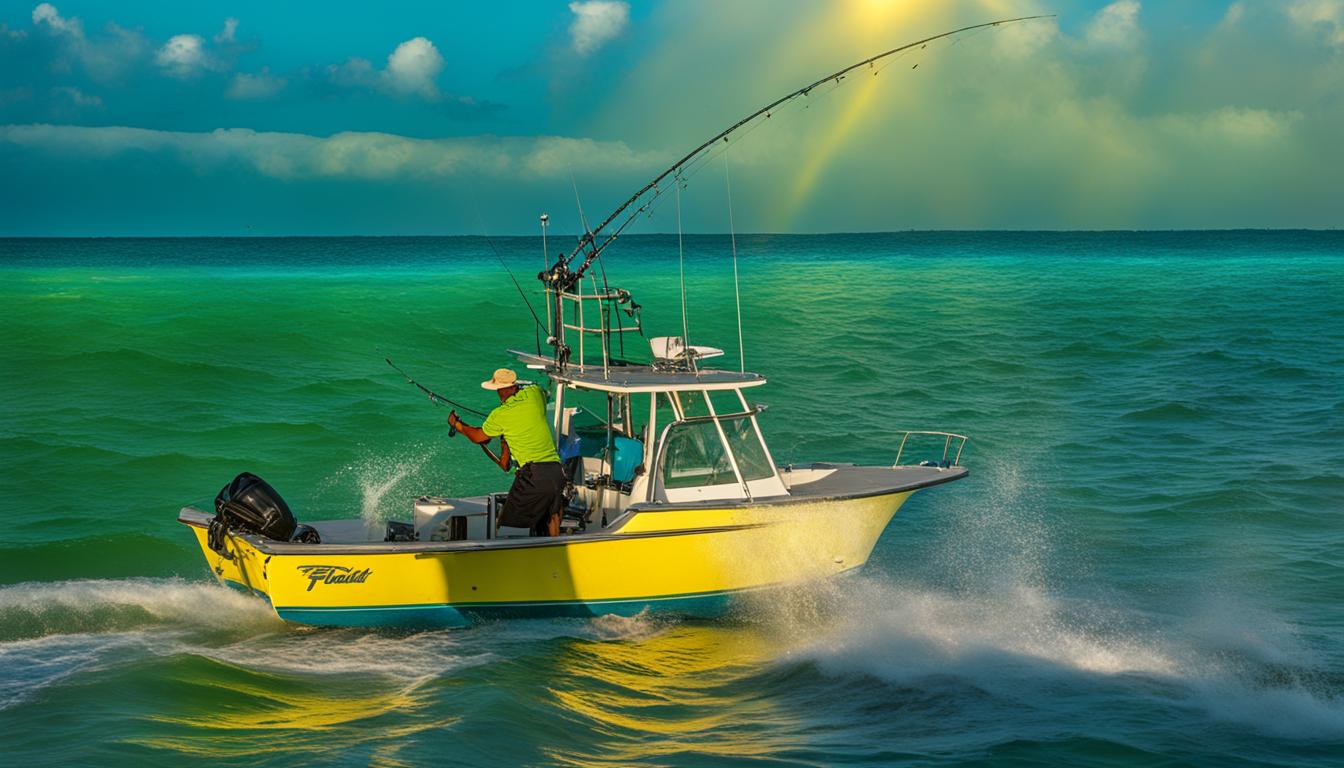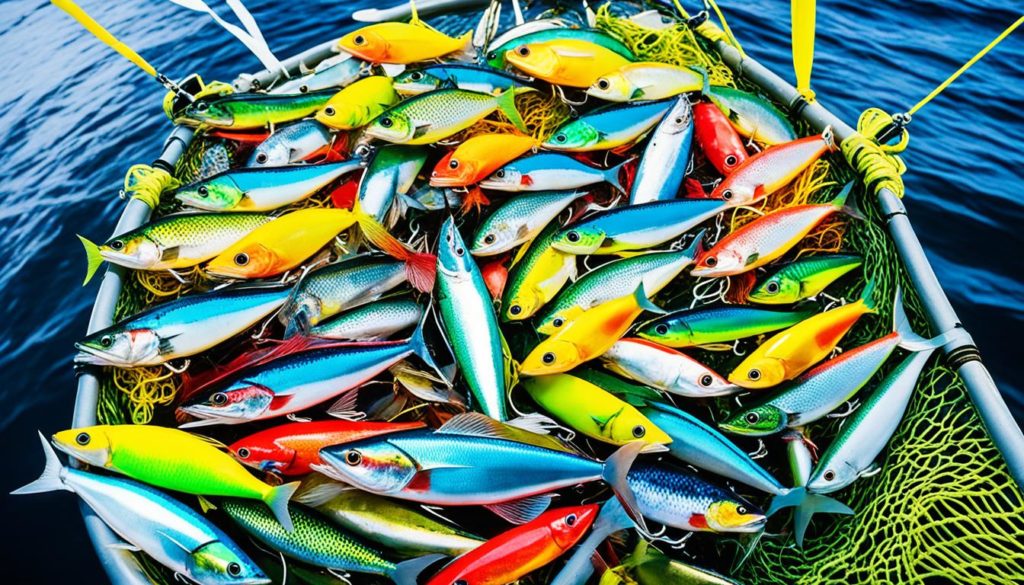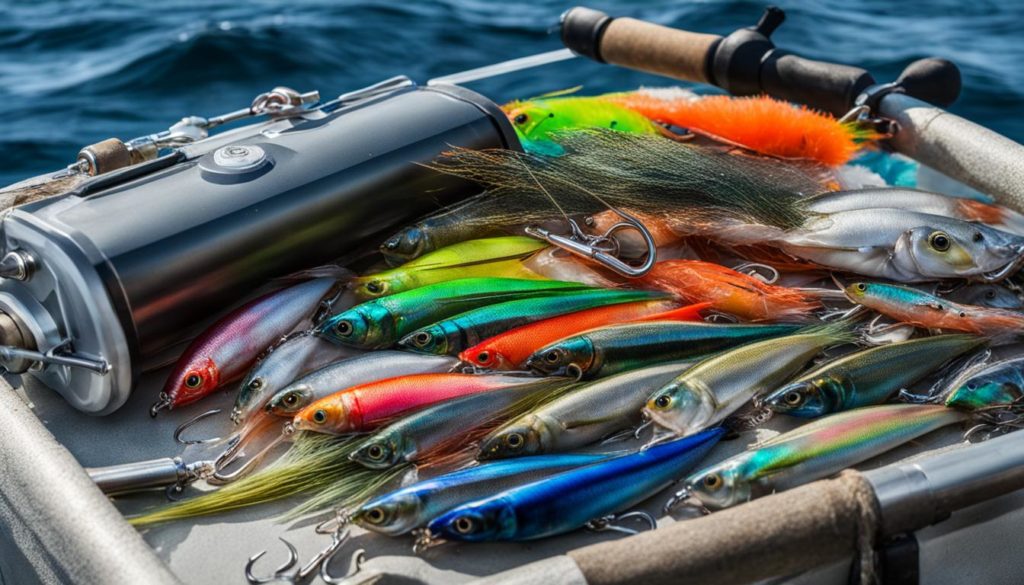Are you ready for an unforgettable angling experience in the sunny waters of Florida? If you’re looking to catch the prized Mahi Mahi, also known as Dolphin or Dorado, this comprehensive guide is just what you need. In this guide, we’ll share the best techniques, fishing spots, and tips to help you reel in these magnificent fish.
Key Takeaways:
- Learn the best techniques for catching Mahi Mahi in Florida
- Discover the top fishing spots where Mahi Mahi can be found
- Find out about the preferred bait and lures for attracting Mahi Mahi
- Understand the fishing regulations and gear requirements in Florida
- Get useful tips for cleaning and preparing Mahi Mahi for cooking
Where to Catch Mahi Mahi in Florida
When it comes to catching Mahi Mahi in Florida, there are several top locations that offer excellent opportunities for anglers. Whether you’re a seasoned fisherman or a beginner, these spots are known for their abundance of Mahi Mahi and the thrilling fishing experiences they provide.
- Florida Keys: The Florida Keys are renowned for their exceptional Mahi Mahi fishing. Key West, in particular, is a hotspot for this species. Head out to the deep waters surrounding the keys, and you’ll have a good chance of reeling in some impressive Mahi Mahi.
- Atlantic Coast of Florida: Along the Atlantic Coast of Florida, you’ll find a variety of locations that are perfect for Mahi Mahi fishing. Stuart, Port Canaveral, and Miami are popular destinations that offer fruitful waters for catching this prized game fish.
These areas are optimal for Mahi Mahi fishing because they are situated close to the shore, typically within 10 miles offshore. Mahi Mahi are known to be attracted to floating objects and can often be found near weedlines, floating structure, and rip currents.
Mahi Mahi fishing in Florida offers not only the chance to catch this beautiful species but also the opportunity to explore the breathtaking coastal scenery and enjoy the thrill of the ocean. So, pack your fishing gear, head to these prime locations, and get ready for an unforgettable Mahi Mahi fishing adventure.
Mahi Mahi Fishing Techniques
When it comes to catching Mahi Mahi, trolling is the tried and true technique favored by anglers. You have the option to troll along weedlines, around floating structure, or in rip currents, all of which can attract these beautiful fish. The recommended trolling speed for Mahi Mahi fishing is between 2 and 9 knots, allowing you to cover a good amount of water and increase your chances of a successful catch.
“Trolling is the most popular technique for catching Mahi Mahi. Anglers can troll along weedlines, around floating structure, or in rip currents.”
To maximize your chances of hooking a Mahi Mahi, it’s recommended to have a spread of 3 to 4 rods with rigged ballyhoo or artificial lures. Rigged ballyhoo mimics the natural baitfish that Mahi Mahi feed on, making it an effective choice. Alternatively, you can use artificial lures designed to attract these fish with their vibrant colors and lifelike action. Pink and blue are popular lure colors for Mahi Mahi.
Another technique that can yield great results is casting near weed lines, buoys, or floating seaweed. Mahi Mahi are opportunistic feeders and will often bite fast-moving baits. By casting and reeling in your bait near these structures, you can entice Mahi Mahi to strike.
Mahi Mahi Fishing Techniques Summary:
- Trolling along weedlines, floating structure, or in rip currents
- Recommended trolling speed: 2 to 9 knots
- A spread of 3 to 4 rods with rigged ballyhoo or artificial lures
- Casting near weed lines, buoys, or floating seaweed
To further enhance your understanding of Mahi Mahi fishing techniques, refer to the table below, which summarizes the key aspects of each method.
| Technique | Description |
|---|---|
| Trolling | Trolling along weedlines, floating structure, or in rip currents at a speed of 2 to 9 knots. |
| Rigged Ballyhoo | Using rigged ballyhoo as bait to mimic the natural prey of Mahi Mahi. |
| Artificial Lures | Using colorful and lifelike artificial lures to attract Mahi Mahi. |
| Casting | Casting near weed lines, buoys, or floating seaweed to entice Mahi Mahi. |
By employing these techniques and experimenting with different approaches, you can increase your chances of a successful day of Mahi Mahi fishing.
Best Bait and Lures for Mahi Mahi
When it comes to catching Mahi Mahi, using the right bait and lures can make all the difference. These fish have big appetites and will often strike at anything that gets in their way. Here are some of the best baits and lures that you can use to increase your chances of success:
- Rigged Ballyhoo: This is one of the most popular baits for Mahi Mahi. Rigged ballyhoo mimics the appearance of small baitfish, making it irresistible to these voracious predators.
- Squid: Mahi Mahi are known to be attracted to squid. You can use whole squid or squid strips as bait to entice them.
- Pilchards: These small fish are a favorite among Mahi Mahi. Live or cut pilchards can be effective bait, especially when fished near floating structure or weedlines.
- Cut or Live Bait: Mahi Mahi will strike at cut bait such as mullet or bonito. Live baits like goggle eyes or threadfin herring can also be successful.
Along with natural baits, artificial lures can also be highly effective in attracting Mahi Mahi. Here are some top lures to consider:
- Chugger Heads: These lures create a commotion on the water’s surface, imitating the splash and noise of feeding fish. Mahi Mahi are drawn to the action.
- Diving Plugs: Diving plugs can be trolled at different depths, making them versatile for targeting Mahi Mahi at various levels in the water column.
- Soft Plastic Jigs: Soft plastic jigs in vibrant colors can attract Mahi Mahi from a distance. Their lifelike movements make them irresistible to these fish.
- Artificial Squid: Artificial squid lures can mimic the appearance and movement of real squid. These lures can be trolled or casted near weed lines and floating structure.
To increase your chances of success, consider using lures in pink and blue colors, as these are known to be particularly effective for Mahi Mahi. Experimenting with different baits and lures can help you find what works best for your specific fishing conditions.
Mahi Mahi Trolling Tips
When it comes to catching Mahi Mahi, trolling is one of the most effective techniques. To optimize your trolling success, follow these expert tips:
- Vary your trolling speed until you get a bite, but maintain a steady pace. Mahi Mahi are known to be attracted to faster-moving baits.
- Keep your boat moving within a range of 2 to 9 knots. This speed range allows you to cover a larger area and increase your chances of encountering Mahi Mahi.
- Focus on trolling near weedlines, floating structure, and rip currents. These are prime areas where Mahi Mahi are often found feeding.
- Use a spread of 3 to 4 rods in the water to increase your chances of enticing a Mahi Mahi. Rigged ballyhoo and artificial lures are popular bait choices.
- Consider using lures in pink and blue colors. These colors are known to attract Mahi Mahi and increase your chances of getting a bite.
Remember, trolling for Mahi Mahi requires patience and persistence. By following these trolling tips, you’ll be on your way to a successful fishing trip.
You never know what may be lurking beneath the surface, so keep your baits moving and be ready for a Mahi Mahi to strike at any moment.
Expert Insight
“Trolling for Mahi Mahi requires a good mix of technique and luck. Vary your speeds, experiment with different bait placements, and stay alert for any signs of activity. When that rod bends, it’s a thrill you won’t soon forget!” – Captain Mike Johnson, Mahi Mahi Fishing Expert
Mahi Mahi Drift Fishing Tips
Drift fishing can be an effective technique for targeting Mahi Mahi, especially when fishing around weed lines and floating structures. By allowing your bait or lure to naturally drift with the current or wind, you can increase your chances of enticing Mahi Mahi to strike. Here are some valuable drift fishing tips to improve your success:
- Pay attention to signs of Mahi Mahi activity: Keep an eye out for birds diving or hovering above the water, as they can indicate the presence of Mahi Mahi feeding below the surface. Surface disturbances such as splashing or jumping fish may also give away their location.
- Adjust your drift speed and direction: Experiment with different drift speeds and directions to cover a larger area and increase your chances of encountering active Mahi Mahi. Note the direction of the current or wind and adjust accordingly.
- Stay near weed lines and floating structure: Mahi Mahi are often found around weed lines, floating mats of seaweed, debris, or other structures that provide shelter and attract smaller baitfish. Drift fishing along these areas can yield excellent results.
Remember, drift fishing requires patience and observation. Stay alert, adapt to changing conditions, and be prepared to make adjustments to your drift as needed. By following these drift fishing tips, you can enhance your chances of landing that coveted Mahi Mahi catch!
Mahi Mahi Fishing Gear and Equipment
When it comes to Mahi Mahi fishing, having the right gear and equipment is essential for a successful and enjoyable fishing experience. Here are the recommended tackle and gear options for catching Mahi Mahi:
Rods
For targeting Mahi Mahi, a 7′-8′ heavy-action rod is recommended. This type of rod provides the strength and flexibility needed to handle the fight of these powerful fish. A medium-heavy spinning rod can also be used for lighter tackle and casting.
Lines
Pair your rod with a 30-50 lb braided or fused line. Braided lines offer high strength and thin diameter, allowing for longer casts and better sensitivity to detect bites. Fused lines provide similar benefits with the added advantage of reduced line spooling and twisting.
Leaders
Fluorocarbon leaders in 30-80 lb test are commonly used for Mahi Mahi fishing. Fluorocarbon leaders are virtually invisible underwater, which can increase your chances of getting bites. They also offer excellent abrasion resistance, ensuring your line is less likely to break during the fight.
Baits and Lures
Popular baits for Mahi Mahi include ballyhoo, squid, and pilchards. These natural baits imitate the forage that Mahi Mahi commonly feed on and can be rigged in various ways to increase their attractiveness. Additionally, artificial lures like chugger heads and diving plugs are effective in enticing Mahi Mahi to strike.
Here’s an example of a table showcasing the recommended gear and equipment for Mahi Mahi fishing:
| Tackle | Recommended Options |
|---|---|
| Rods | 7′-8′ heavy-action rod |
| Lines | 30-50 lb braided or fused line |
| Leaders | Fluorocarbon leaders (30-80 lb test) |
| Baits | Ballyhoo, squid, pilchards |
| Lures | Chugger heads, diving plugs |
Remember to choose gear and tackle that match your fishing style and preferences. Having the right equipment can make all the difference in landing that trophy Mahi Mahi!
Mahi Mahi Fishing Regulations in Florida
When it comes to Mahi Mahi fishing in Florida, it’s important to understand and follow the fishing regulations to ensure the sustainability of the species and the preservation of the ecosystem. The regulations set limits on the size and quantity of Mahi Mahi that can be caught per person or vessel.
Size Limit for Mahi Mahi in Florida
In Florida, there is a minimum size limit for Mahi Mahi. According to the regulations, Mahi Mahi must have a fork length of at least 20″. The fork length is measured from the tip of the jaw to the center of the fork in the tail.
Bag Limit for Mahi Mahi in Florida
The bag limit determines the maximum number of Mahi Mahi that can be harvested per person or vessel. In Florida, the daily bag limit for Mahi Mahi is 10 fish per person or 60 fish per vessel, whichever is less. It’s important to adhere to these limits to ensure the sustainability of the fishery and allow for future generations to enjoy the thrill of Mahi Mahi fishing.
Legal Gear Allowed for Mahi Mahi Fishing in Florida
When it comes to the gear allowed for catching Mahi Mahi in Florida, the regulations only permit the use of hook and line or spearing. Using other types of gear, such as nets or traps, is not allowed for targeting Mahi Mahi. By using the legal gear, anglers can ensure a fair and responsible fishing experience.
Follow these regulations to enjoy Mahi Mahi fishing in Florida while contributing to the conservation efforts of this amazing fish species.
| Regulation | Requirement |
|---|---|
| Size Limit | 20″ fork length |
| Bag Limit | 10 fish per person or 60 fish per vessel, whichever is less |
| Legal Gear | Hook and line or spearing |
Mahi Mahi Cleaning and Preparation
Cleaning and preparing Mahi Mahi for cooking is an essential step to ensure delicious and flavorful meals. Follow these simple methods to effectively clean and fillet your Mahi Mahi:
Removing the Scales
Start by rinsing the Mahi Mahi under cold running water. Using a sharp knife, scrape off the scales in a downward motion, starting from the tail towards the head. Be careful to remove all the scales, as they can affect the taste and texture of the fish when cooked.
Gutting the Fish
With a clean workspace and a sharp knife, make an incision on the underside of the Mahi Mahi from the belly to the gills. Carefully remove the entrails and discard them. Rinse the cavity thoroughly with cold water to remove any remaining blood or debris.
Filleting the Meat
Once the Mahi Mahi is scaled and gutted, proceed to fillet the fish. Place the fish on a cutting board and locate the backbone. Using a sharp fillet knife, make a small incision behind the gills and carefully slide the knife along the backbone, following the natural curvature of the fish. Repeat the process on the other side to obtain two fillets.
Trim away any remaining small bones or rib bones from the fillets using tweezers or pliers. Rinse the fillets under cold water to remove any loose scales or debris. Pat the fillets dry with a paper towel before cooking.
Mahi Mahi fillets can be prepared using various cooking methods, including grilling, baking, or frying. Their firm texture and mild flavor make them a versatile option for creating delicious meals.
Now that you know how to clean and fillet Mahi Mahi, you can confidently handle this popular fish and enjoy its delectable taste in your favorite recipes.
Tips for a Successful Mahi Mahi Fishing Trip
To increase your chances of a successful Mahi Mahi fishing trip, it’s important to keep in mind some valuable tips and strategies:
- Research the best locations and times to fish: Mahi Mahi can be found in different areas and depths depending on the time of year. Do some research or talk to local fishermen to find out the best spots and seasons for Mahi Mahi fishing.
- Pay attention to weather conditions and water temperatures: Mahi Mahi are sensitive to changes in weather and water temperatures. Check the weather forecast and sea conditions before your fishing trip to ensure optimal fishing conditions.
- Use the appropriate gear and bait: Depending on the fishing technique you’re using, make sure to have the right gear and bait. Trolling requires sturdy rods and reels, while drifting may require lighter tackle. Use colorful lures or natural baits such as ballyhoo or squid to attract Mahi Mahi.
- Stay observant for signs of Mahi Mahi activity: Keep an eye out for birds diving or circling above the water, as they often indicate the presence of Mahi Mahi feeding near the surface. Look for floating structures or weed lines where Mahi Mahi tend to gather.
By following these expert tips and strategies, you can greatly improve your chances of landing Mahi Mahi on your next fishing trip.
Mahi Mahi Fishing Safety Tips
When fishing for Mahi Mahi, prioritizing safety is essential to ensure a successful and enjoyable experience. Follow these essential safety tips to stay safe while fishing for Mahi Mahi:
- Always wear a life jacket or personal flotation device (PFD) when on the water: Wearing a properly fitted life jacket can save your life in case of an accident or emergency. Make sure everyone on board has a life jacket that fits them correctly.
- Be cautious of the weather conditions: Before heading out, check the weather forecast and any advisories or warnings. Avoid fishing in severe weather conditions such as storms or high winds. If the weather worsens unexpectedly while you’re on the water, head back to shore immediately.
- Prepare necessary safety equipment: Bring a well-stocked first aid kit, emergency signaling devices such as flares or a whistle, a VHF radio for communication, and a fully charged cellphone in case of emergencies. These items can be crucial in ensuring your safety and the safety of your fellow anglers.
- Inform others about your fishing plans: Before heading out, let someone onshore know your fishing plans, including the location and expected return time. This ensures that someone is aware of your whereabouts and can take appropriate action if you don’t return as planned.
By following these mahi mahi fishing safety tips, you can have a safe and enjoyable fishing experience while targeting this exciting game fish.
Conclusion
In conclusion, Mahi Mahi fishing in Florida offers anglers an exciting and vibrant experience. By following the techniques and tips outlined in this guide, you can increase your chances of a successful Mahi Mahi fishing trip. Remember to choose the right gear, use the appropriate bait and lures, and be observant of the signs of Mahi Mahi activity. Stay safe on the water and enjoy the thrill of catching this beautiful game fish.
FAQ
How can I catch Mahi Mahi in Florida?
There are various techniques you can try, including trolling along weedlines or near floating structures, casting near buoys or floating seaweed, and drift fishing around weed lines. Use live bait, cut bait, or artificial lures to attract Mahi Mahi.
Where are the best spots for catching Mahi Mahi in Florida?
Some of the top locations for Mahi Mahi fishing in Florida include the Florida Keys, the Atlantic Coast of Florida, Key West, Stuart, Port Canaveral, and Miami. These areas have productive waters where Mahi Mahi can be found close to the shore, within 10 miles offshore.
What are the recommended techniques for Mahi Mahi fishing?
The most popular technique for catching Mahi Mahi is trolling. You can also try casting near weedlines or floating structures, or drift fishing around weed lines. Mahi Mahi are opportunistic feeders, so fast-moving baits are often effective.
What baits and lures work best for Mahi Mahi?
The preferred baits for Mahi Mahi include rigged ballyhoo, squid, pilchards, and cut or live bait. Artificial lures such as chugger heads, diving plugs, soft plastic jigs, and artificial squid are also effective. Pink and blue are popular lure colors for Mahi Mahi.
What are some tips for Mahi Mahi trolling?
To troll for Mahi Mahi, vary your trolling speed and maintain a steady pace between 2 and 9 knots. Troll along weedlines, near floating structures, or in rip currents. Use a spread of 3 to 4 rods with rigged ballyhoo or artificial lures, and experiment with different colors to attract Mahi Mahi.
Any tips for Mahi Mahi drift fishing?
When drift fishing for Mahi Mahi, allow your bait or lure to drift naturally with the current or wind. Pay attention to signs of Mahi Mahi activity, such as birds or surface disturbances, and adjust your drift speed and direction accordingly to cover areas where Mahi Mahi are likely to be feeding.
What gear and equipment do I need for Mahi Mahi fishing?
Recommended gear for Mahi Mahi fishing includes a 7′-8′ heavy-action rod paired with a 30-50 lb braided or fused line. For trolling, a 6′-7′ rod capable of holding a 30-50 lb line is recommended. Fluorocarbon leaders in 30-80 lb test are commonly used. Ballyhoo, squid, and pilchards are popular baits, and artificial lures like chugger heads and diving plugs are effective.
What are the fishing regulations for Mahi Mahi in Florida?
In Florida, the minimum size limit for Mahi Mahi is 20″ fork length, measured from the tip of the jaw to the center of the fork in the tail. The daily bag limit is 10 fish per person or 60 fish per vessel, whichever is less. The legal gear allowed for catching Mahi Mahi in Florida is hook and line or spearing.
How do I clean and prepare Mahi Mahi for cooking?
To clean and prepare Mahi Mahi, remove the scales, gut the fish, and fillet the meat. Use a sharp knife and clean workspace for the process. Mahi Mahi fillets can be grilled, baked, or fried, and are known for their firm texture and mild flavor.
What are some tips for a successful Mahi Mahi fishing trip?
Research the best locations and times to fish for Mahi Mahi, pay attention to weather conditions and water temperatures, use the appropriate gear and bait for your fishing technique, and stay observant for signs of Mahi Mahi activity, such as birds or floating structure.
How can I ensure my safety while Mahi Mahi fishing?
Always wear a life jacket or personal flotation device, be aware of weather conditions and any advisories or warnings, carry necessary safety equipment like a first aid kit and emergency signaling devices, bring a VHF radio, and let someone know your fishing plans and expected return time.



